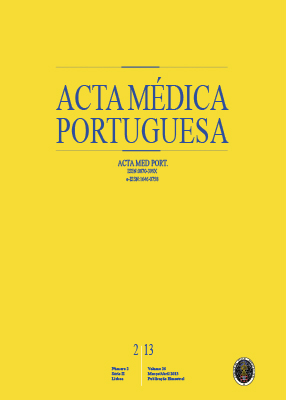Alcohol Consumption in the Schooled Youth: an Old Question Revisited
DOI:
https://doi.org/10.20344/amp.4106Abstract
Introduction: Adolescents crave for new experiences. Alcohol consumption arises in this context as an attitude trivialized and sometimes even urged socially, since access to alcohol is facilitated. It is associated to risky behaviors, with serious consequences for public health. Material and Methods: A descriptive cross-sectional through an anonymous questionnaire applied to pupils in the district of Leiria. Results: The final sample consisted of 405 individuals, 56% female, mean age of 16.5 ± 1 years (15 - 18 years). The majority (48%) attended the 10th grade, 15.4% had reproved at least once. Ninety percent of the individuals had already consumed alcohol, at least once. The first contact with the alcohol was preferentially with friends (63%) in most cases due to curiosity (47%). The results showed higher rates of beer consumption and higher educational failure in males compared to females, which had a higher consumption of distilled beverages. In both sexes, there was a tendency for “binge drinking”. The majority of the individuals (60%) consumed an average of 2-3 glasses per occasion but about 30% of boys reported consuming more than 4 drinks per occasion (7% until they are drunk), a trend that was not observed in girls. Most consumption took place in bars and nightclubs (60%). It was found that 41% of respondents went out at night at least once a week, 66% started out at night between 13 and 15 years of age, when they went 70% used to drink alcohol and 9% had experienced drugs at least once. When asked about false myths about alcohol, about 20% of young people felt that alcoholic beverages may quench your thirst, 34% believed that alcohol whet your appetite, 15.4% believed that there was no problem driving if they had not drunk a lot. Conclusion: The pattern of alcohol consumption in these adolescents is worrisome and with characteristics similar to those reported in other European studies. A strategy is needed urgently to change this old paradigm.
Downloads
Downloads
How to Cite
Issue
Section
License
All the articles published in the AMP are open access and comply with the requirements of funding agencies or academic institutions. The AMP is governed by the terms of the Creative Commons ‘Attribution – Non-Commercial Use - (CC-BY-NC)’ license, regarding the use by third parties.
It is the author’s responsibility to obtain approval for the reproduction of figures, tables, etc. from other publications.
Upon acceptance of an article for publication, the authors will be asked to complete the ICMJE “Copyright Liability and Copyright Sharing Statement “(http://www.actamedicaportuguesa.com/info/AMP-NormasPublicacao.pdf) and the “Declaration of Potential Conflicts of Interest” (http:// www.icmje.org/conflicts-of-interest). An e-mail will be sent to the corresponding author to acknowledge receipt of the manuscript.
After publication, the authors are authorised to make their articles available in repositories of their institutions of origin, as long as they always mention where they were published and according to the Creative Commons license.









